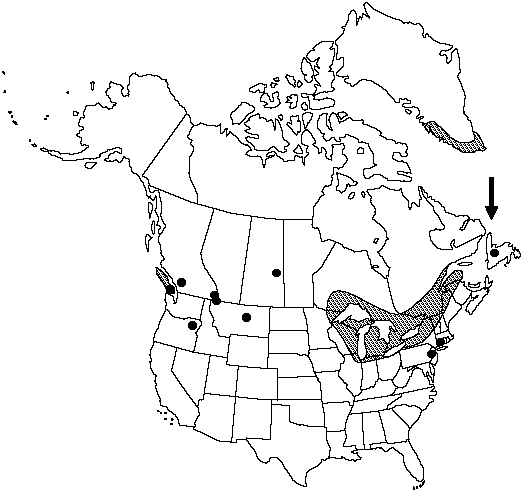Difference between revisions of "Equisetum ×mackaii"
Phytologist 1: 369. 1843 (Nov. 1842.
Basionym: Equisetum hyemale var. mackaii Newman
Synonyms: Equisetum hyemale subsp. trachyodon A.BraunEquisetum ×trachyodon Schleicher ex F. Weber & D. MohrEquisetum variegatum var. jesupii A.A. Eaton
Treatment appears in FNA Volume 2.
FNA>Volume Importer |
FNA>Volume Importer |
||
| Line 28: | Line 28: | ||
}}<!-- | }}<!-- | ||
| − | --><span class="statement" id="st- | + | --><span class="statement" id="st-undefined" data-properties=""><b>Aerial </b>stems persisting more than a year, unbranched, 20–86 cm; lines of stomates single; ridges 7–16. <b>Sheaths</b> black or black-girdled and white distally, appressed, elongate, 3.5–8 × 2–5.5 mm; teeth 7–16, centers dark, margins white, prominent, not articulate, tip usually brown, long, filiform. <b>Cone</b> apex pointed; spores white, misshapen.</span><!-- |
-->{{Treatment/Body | -->{{Treatment/Body | ||
| + | |phenology=Cones maturing in late summer, but misshapen spores not shed. | ||
|habitat=Lakeshores, riverbanks, marshes | |habitat=Lakeshores, riverbanks, marshes | ||
|elevation=0–500 m | |elevation=0–500 m | ||
| Line 50: | Line 51: | ||
|basionyms=Equisetum hyemale var. mackaii | |basionyms=Equisetum hyemale var. mackaii | ||
|family=Equisetaceae | |family=Equisetaceae | ||
| + | |phenology=Cones maturing in late summer, but misshapen spores not shed. | ||
|habitat=Lakeshores, riverbanks, marshes | |habitat=Lakeshores, riverbanks, marshes | ||
|elevation=0–500 m | |elevation=0–500 m | ||
| Line 57: | Line 59: | ||
|publication year=1842 | |publication year=1842 | ||
|special status= | |special status= | ||
| − | |source xml=https://jpend@bitbucket.org/aafc-mbb/fna- | + | |source xml=https://jpend@bitbucket.org/aafc-mbb/fna-data-curation.git/src/9216fc802291cd3df363fd52122300479582ede7/coarse_grained_fna_xml/V2/V2_531.xml |
|genus=Equisetum | |genus=Equisetum | ||
|subgenus=Equisetum subg. Equisetum | |subgenus=Equisetum subg. Equisetum | ||
|species=Equisetum ×mackaii | |species=Equisetum ×mackaii | ||
| − | |||
| − | |||
| − | |||
| − | |||
| − | |||
| − | |||
| − | |||
| − | |||
| − | |||
| − | |||
| − | |||
| − | |||
| − | |||
| − | |||
| − | |||
| − | |||
| − | |||
| − | |||
| − | |||
| − | |||
| − | |||
}}<!-- | }}<!-- | ||
-->[[Category:Treatment]][[Category:Equisetum subg. Equisetum]] | -->[[Category:Treatment]][[Category:Equisetum subg. Equisetum]] | ||
Revision as of 13:22, 27 July 2019
Aerial stems persisting more than a year, unbranched, 20–86 cm; lines of stomates single; ridges 7–16. Sheaths black or black-girdled and white distally, appressed, elongate, 3.5–8 × 2–5.5 mm; teeth 7–16, centers dark, margins white, prominent, not articulate, tip usually brown, long, filiform. Cone apex pointed; spores white, misshapen.
Phenology: Cones maturing in late summer, but misshapen spores not shed.
Habitat: Lakeshores, riverbanks, marshes
Elevation: 0–500 m
Distribution

Greenland, B.C., N.B., Nfld., Ont., Que., Sask., Conn., Ill., Ind., Maine, Mich., Minn., Mont., N.H., N.J., N.Y., Ohio, Oreg., Vt., Wis., n Europe.
Discussion
The hybrid between Equisetum hyemale and E. variegatum, E. × mackaii, is often mistaken for small forms of E. hyemale. I have not seen specimens for the reports from Connecticut and New Hampshire.
Selected References
None.
Lower Taxa
None.